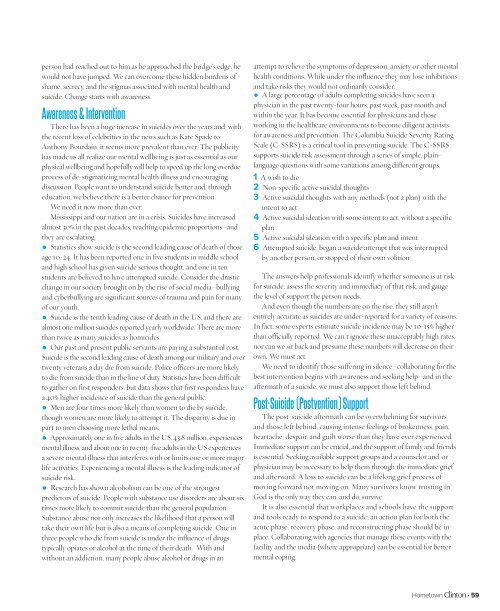You also want an ePaper? Increase the reach of your titles
YUMPU automatically turns print PDFs into web optimized ePapers that Google loves.
person had reached out to him as he approached the bridge’s edge, he<br />
would not have jumped. We can overcome these hidden burdens of<br />
shame, secrecy, and the stigmas associated with mental health and<br />
suicide. Change starts with awareness.<br />
Awareness & Intervention<br />
There has been a huge increase in suicides over the years and, with<br />
the recent loss of celebrities in the news such as Kate Spade to<br />
Anthony Bourdain, it seems more prevalent than ever. The publicity<br />
has made us all realize our mental wellbeing is just as essential as our<br />
physical wellbeing and hopefully will help to speed up the long overdue<br />
process of de-stigmatizing mental health illness and encouraging<br />
discussion. People want to understand suicide better and, through<br />
education, we believe there is a better chance for prevention.<br />
We need it now more than ever.<br />
Mississippi and our nation are in a crisis. Suicides have increased<br />
almost 30% in the past decades, reaching epidemic proportions–and<br />
they are escalating.<br />
• Statistics show suicide is the second leading cause of death of those<br />
age 10-24. It has been reported one in five students in middle school<br />
and high school has given suicide serious thought, and one in ten<br />
students are believed to have attempted suicide. Consider the drastic<br />
change in our society brought on by the rise of social media–bullying<br />
and cyberbullying are significant sources of trauma and pain for many<br />
of our youth.<br />
• Suicide is the tenth leading cause of death in the US, and there are<br />
almost one million suicides reported yearly worldwide. There are more<br />
than twice as many suicides as homicides.<br />
• Our past and present public servants are paying a substantial cost.<br />
Suicide is the second leading cause of death among our military and over<br />
twenty veterans a day die from suicide. Police officers are more likely<br />
to die from suicide than in the line of duty. Statistics have been difficult<br />
to gather on first responders, but data shows that first responders have<br />
a 40% higher incidence of suicide than the general public.<br />
• Men are four times more likely than women to die by suicide,<br />
though women are more likely to attempt it. The disparity is due in<br />
part to men choosing more lethal means.<br />
• Approximately one in five adults in the US, 43.8 million, experiences<br />
mental illness, and about one in twenty-five adults in the US experiences<br />
a severe mental illness that interferes with or limits one or more major<br />
life activities. Experiencing a mental illness is the leading indicator of<br />
suicide risk.<br />
• Research has shown alcoholism can be one of the strongest<br />
predictors of suicide. People with substance use disorders are about six<br />
times more likely to commit suicide than the general population.<br />
Substance abuse not only increases the likelihood that a person will<br />
take their own life but is also a means of completing suicide. One in<br />
three people who die from suicide is under the influence of drugs,<br />
typically opiates or alcohol at the time of their death. With and<br />
without an addiction, many people abuse alcohol or drugs in an<br />
attempt to relieve the symptoms of depression, anxiety or other mental<br />
health conditions. While under the influence they may lose inhibitions<br />
and take risks they would not ordinarily consider.<br />
• A large percentage of adults completing suicides have seen a<br />
physician in the past twenty-four hours, past week, past month and<br />
within the year. It has become essential for physicians and those<br />
working in the healthcare environments to become diligent activists<br />
for awareness and prevention. The Columbia Suicide Severity Rating<br />
Scale (C-SSRS) is a critical tool in preventing suicide. The C-SSRS<br />
supports suicide risk assessment through a series of simple, plainlanguage<br />
questions with some variations among different groups.<br />
1 A wish to die<br />
2 Non-specific active suicidal thoughts<br />
3 Active suicidal thoughts with any methods (not a plan) with the<br />
intent to act<br />
4 Active suicidal ideation with some intent to act, without a specific<br />
plan<br />
5 Active suicidal ideation with a specific plan and intent<br />
6 Attempted suicide, began a suicide attempt that was interrupted<br />
by another person, or stopped of their own volition<br />
The answers help professionals identify whether someone is at risk<br />
for suicide, assess the severity and immediacy of that risk, and gauge<br />
the level of support the person needs.<br />
And even though the numbers are on the rise, they still aren’t<br />
entirely accurate as suicides are under-reported for a variety of reasons.<br />
In fact, some experts estimate suicide incidence may be 10-15% higher<br />
than officially reported. We can't ignore these unacceptably high rates,<br />
nor can we sit back and presume these numbers will decrease on their<br />
own. We must act.<br />
We need to identify those suffering in silence–collaborating for the<br />
best intervention begins with awareness and seeking help–and in the<br />
aftermath of a suicide, we must also support those left behind.<br />
Post-Suicide (Postvention) Support<br />
The post-suicide aftermath can be overwhelming for survivors<br />
and those left behind, causing intense feelings of brokenness, pain,<br />
heartache, despair, and guilt worse than they have ever experienced.<br />
Immediate support can be crucial, and the support of family and friends<br />
is essential. Seeking available support groups and a counselor and/or<br />
physician may be necessary to help them through the immediate grief<br />
and afterward. A loss to suicide can be a lifelong grief process of<br />
moving forward not moving on. Many survivors know trusting in<br />
God is the only way they can, and do, survive.<br />
It is also essential that workplaces and schools have the support<br />
and tools ready to respond to a suicide; an action plan for both the<br />
acute phase, recovery phase, and reconstructing phase should be in<br />
place. Collaborating with agencies that manage these events with the<br />
facility and the media (where appropriate) can be essential for better<br />
mental coping.<br />
Hometown Clinton • 59

















